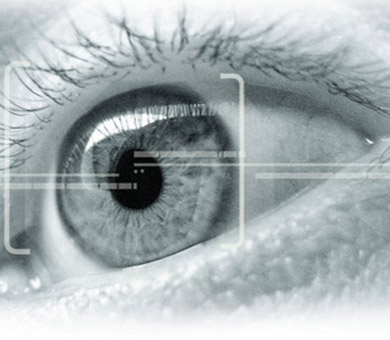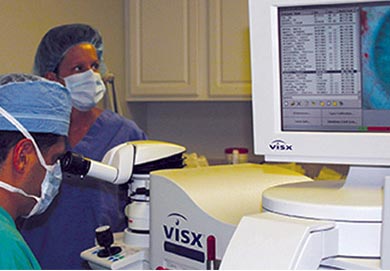What is LASIK?
What is LASIK?What is LASIK?
LASIK is a Laser Vision Correction procedure designed to treat moderate to high amounts of nearsightedness, farsightedness, and astigmatism.
What is LASIK?
LASIK is a Laser Vision Correction procedure designed to treat moderate to high amounts of nearsightedness, farsightedness, and astigmatism. It does so by reshaping the surface of the cornea to bring vision back into focus.
How LASIK Works?

How LASIK Works?
LASIK is a highly specialized procedure that combines the use of a microkeratome surgical instrument with the precise vision correction beam of the Excimer Laser. The first step in the LASIK procedure is to create a flap of tissue on the cornea of the eye. This is done using the microkeratome.
This thin flap of tissue is then placed back to expose the underlying surface of the cornea where the laser energy will be applied. Once the cornea flap has been positioned, Dr. Jaoude then uses a computer selected amount of laser energy to remove the desired amount of cornea tissue for laser correction. This normally takes just a few seconds to complete. Once the desired amount of laser correction has been applied, the corneal flap is placed into its original position and allowed to heal. No sutures are required to hold the corneal flap in place. All of these procedures are performed by Dr. Jaoude using topical anesthesia, meaning that no injections of anesthesia are necessary. This helps our patients see better in a shorter period of time.
What is PRK?

What is PRK?
LASIK is a Laser Vision Correction procedure designed to treat moderate to high amounts of nearsightedness, farsightedness, and astigmatism. It does so by reshaping the surface of the cornea to bring vision back into focus.
What is Wavefront LASIK or PRK?

What is Wavefront LASIK or PRK?
Wavefront guided Laser Vision Correction technology was originally developed for use in high-powered telescopes to reduce distortions when viewing distant objects in space. Using this technology, Dr Jaoude can detect and measure the optical distortions unique to the entire optical system of your eye. Light travels in a procession of flat sheets known as wavefronts. Gentle wavefront lights enter the eye, pass through the entire optical system (cornea, lens and retina) and are then reflected back into the wavefront analyzer.
The wavefront analyzer compares the reflected wavefront with the original unaltered wavefronts. This produces a fingerprint of your vision. This information is then transferred to the excimer laser and is used as a guide to reshape the cornea during the laser vision treatment.
What is the Advantage of Wavefront LASIK or PRK?
In the past, laser vision correction patients have occasionally complained about their night vision. Of course, these symptoms can even be present in people without LASIK or PRK whose vision is corrected with glasses or contact lenses. However, in the wavefront guided LASIK clinical studies, more people were satisfied or very satisfied with their night vision after their wavefront guided LASIK or PRK as compared to their prior level of satisfaction using glasses or contact lenses
LASIK Frequently Asked Questions
Q: How do I know if I'm a good candidate for laser vision correction of nearsightedness, farsightedness, and/or astigmatism?
Answer
The great majority of all nearsighted, farsighted, and astigmatic Americans are potential candidates for the treatment. Typically, patients who are at least 18 years of age who have mild to moderate nearsightedness, farsightedness, or astigmatism and meet certain medical and visual criteria are suitable. However, only eye doctors, who are specially trained in laser correction of nearsightedness, farsightedness, and/or astigmatism can evaluate your suitability for the treatment.
Q: How do I know LASIK is safe?
Answer
Clinical trials of laser vision correction have been ongoing for many years. The Excimer Laser has been proven safe and effective for the treatment of the majority of nearsighted, farsighted, and astigmatism corrections. In the U.S. clinical trials' three-year follow-up, no sight-threatening complications have occurred. Over 2 million treatments have been performed in the U.S. since 1996.
Q: Is the treatment permanent?
Answer
Yes. Given the results of the U. S. clinical trials and the results reported internationally, the treatment appears to be permanent.
Q: How long does the procedure take?
Answer
The procedure itself takes about 15 minutes, and the pre-op testing approximately 2 hours.
Q: Can LASIK be performed on both eyes the same day?
Answer
Yes.
Q: What % of patients experience visual side effects, especially driving at night?
Answer
At six months post LASIK less than 2% experience halos, glare or star bursting.
Q: Is LASIK ever covered by insurance?
Answer
Most insurance policies consider LASIK a cosmetic procedure and hence do not cover LASIK. However some insurance companies may partially cover LASIK. As a courtesy, we will be happy to check your specific policy.
Q: How old do you have to be for LASIK and is there a cut off age?
Answer
You must be 18 years of age or older, and there is no age limit.
Q: When can I return to work?
Answer
Most patients may return to work one day following LASIK.
Q: Are my eyes patched after the procedure?
Answer
No.
Q: When can I exercise?
Answer
One day after LASIK. Do not let dirty sweat go on the surface of your eye. You need to avoid swimming and hot tubs for 3 weeks after surgery to prevent infections.
Q: Does LASIK hurt?
Answer
No.
Q: How many people have had LASIK?
Answer
Millions of people in the US and around the world have had LASIK.
Q: What is the chance of getting 20/20 vision?
Answer
It depends upon your prescription. Almost all of our patients are able to achieve vision that they are happy with. Most can have an enhancement if needed. Very few still wear corrective lenses after LASIK.
Q: What is the chance of needing an enhancement?
Answer
It depends on your prescription but a good estimate would be about 10%.
Q: When can I fly?
Answer
Immediately following LASIK.
Q: Is Dr Jaoude Board Certified?
Answer
Yes. Dr. Jaoude is certified by the American Board of Ophthalmology, and the National Board of Medical Examiners.
Q: Can I have MonoVision LASIK?
Answer
Yes. With MonoVision LASIK one eye is corrected for close vision and the other for distance vision. 65-75% of patients can adapt to MonoVision. As a courtesy we can test you to see if you can adapt to MonoVision with contact lenses before deciding on Monovision LASIK surgery.
Q: Can I swim and scuba dive following LASIK?
Answer
Yes. 3 weeks following your procedure.
Q: What are the chances that I may not see as well after my procedure?
Answer
There is an extremely small chance of significant decrease of best-corrected visual acuity.
Q: If I am pregnant or nursing how long must I wait to have LASIK?
Answer
Three months not pregnant and/or not breast-feeding.